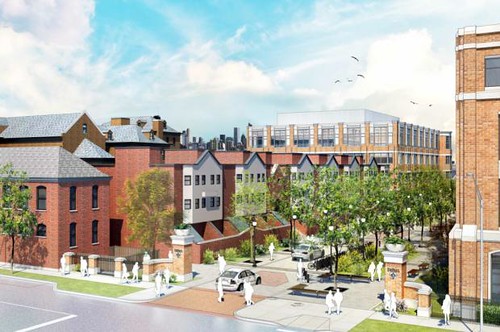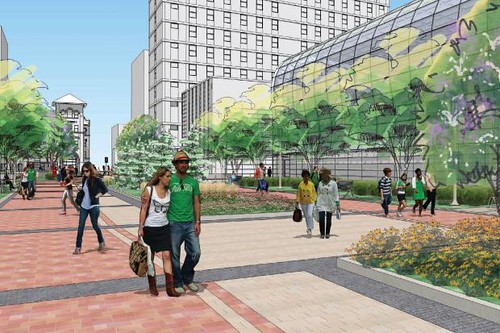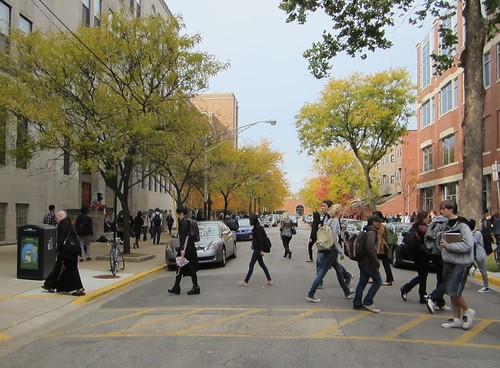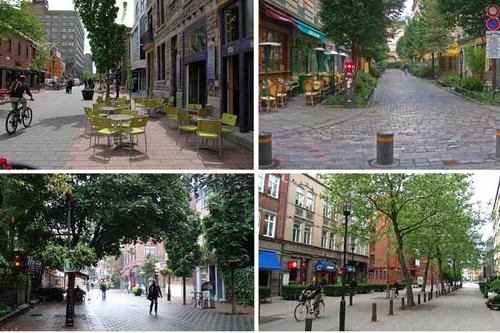Why do some people think Edgewater deserves to have a tranquil, car-free block of Kenmore Avenue running through its local college campus but Lincoln Park doesn’t?
Loyola University is moving forward with its plan to build a completely pedestrianized street on the 6300 block of North Kenmore, which is almost totally surrounded by Loyola-owned buildings. The block should be officially designated as car-free in early November, with construction of the plaza beginning soon afterwards and ending in spring or summer of next year. The project, estimated to cost the university $3.5 million in construction costs plus $330,000 for the purchase of the street, will include new green space, planters, trees, seating and a bike path.
When Loyola floated the idea of pedestrianizing the block, there was opposition from some neighbors, who objected to the elimination of 52 free parking spaces. They were also upset about losing an alternative route to busy Sheridan Road, arguing that traffic from Kenmore would be diverted onto Sheridan, other side streets and alleys.
But at the thirteenth community meeting held on the proposal, residents in attendance voted 40 to 28 in favor of the closure. They realized that the value of having a new, worry-free space for students and neighbors to relax, away from the sight, sound, smell and danger of automobiles, was worth drivers having to make a few adjustments.
Meanwhile, a very similar scene has been unfolding at DePaul University in Lincoln Park, but it looks like the outcome won’t be as positive. Last year the college, which already pedestrianized the 2300 block of North Seminary several years ago to create a lush quadrangle, proposed closing the 2300 block of North Kenmore, one block east, to create a new campus space dubbed Kenmore Green.
Like the Loyola plan, the idea was to provide a car-free place with attractive landscaping, seating and paths that could be enjoyed by students and neighbors alike, on a block that’s surrounded by university-owned buildings. When I dropped by Kenmore for 15 minutes between classes one afternoon, the street was full of students crossing between classroom buildings, but I saw only a handful of cars on this southbound one-way street.
In May of 2012, the city temporarily closed the block to cars for a month to test the concept. A traffic study commissioned by the university found that the closure had a relatively minor impact on parking and traffic in the neighborhood. However, as with the Loyola proposal, nearby residents opposed the elimination of parking spaces (47 in this case, fewer than in Edgewater) and were upset about losing car access to Kenmore, which they argued would drive more traffic to nearby Sheffield Avenue and Racine Avenue.
32nd Ward Alderman Scott Waguespack, a progressive who has recently been on the wrong side of public space issues ranging from the CTA’s Ashland bus rapid transit plan to swapping parking spaces for parklets and Divvy stations, has called for watering down Loyola’s proposal. Following a visit to the Netherlands, Waguespack proposed creating a woonerf on Kenmore rather than a truly car-free space.
Woonerfs, which translates to “living streets," are common in the Netherlands and give priority to pedestrians and cyclists streets but allow drivers to pass through at slow speeds. Since the alderman withdrew his support for their original proposal, DePaul is moving forward with the woonerf idea, and a community meeting to discuss the concept will take place on Tuesday, October 8, at 7 p.m. at the student union, 2250 North Sheffield.
While implementing a woonerf would be innovative elsewhere in Chicago, here Waguespack is presenting it as a compromise solution, and it really amounts to an unnecessary concession. Sure, a Kenmore woonerf could wind up being an interesting and attractive space, with pedestrians, bikes and cars sharing the same the same grade level, cobblestone or brick paving, and landscaping and seating that forces drivers to take a slalom route, slowing them down. But it wouldn’t provide as much parkland as the original Kenmore Green proposal. It also wouldn’t be nearly as serene a space as one where people don’t have to look at cars, let alone worry about being struck by them, even at slow speeds.
On the other hand, many drivers would probably opt against taking a slow, winding drive down Kenmore, so some cars would still be diverted onto nearby streets. The 47 parking spots would still be removed, which means some neighbors are still likely to oppose the woonerf, although DePaul has offered to make up for the loss by granting community members 24-hour access to campus lots and garages.
Evan Jenkins, who writes the South Side urban planning blog Let the Midway Bloom, disagrees with my opinion that altering the Kenmore plan to allow cars represents a loss. In a post titled “The Golden Compromise” he writes:
The woonerf, unlike the original pedestrianization plan, is going to have a huge impact for drivers and non-drivers alike. What drivers lose in speed, they will make up for in humanity. They will be put face-to-face with a living city, rather than stuck in a dead expanse of asphalt and bumpers. Pedestrians will learn that they deserve, and can achieve, freedom of movement without fear of being murdered by indifferent machines. A pedestrian-only block is nice, but it will be ignored by drivers and reproduced only in niche areas of the city. A woonerf can change the way we perceive our urban landscape.
Like I said, a woonerf would be a good thing in another location. The city is already planning to build a “shared street” with wider sidewalks, no curbs, narrower car lanes, and a 15 mph speed limit on Argyle between Broadway and Sheridan Road, and I look forward to seeing that come to fruition. But Kenmore in Lincoln Park is a case where there is no compelling reason to allow any car access at all, and doing so will detract from the otherwise-peaceful pedestrian experience. Instead of watering down their plan, I wish DePaul had been able to follow Loyola’s lead and go for the gusto, creating a car-free and carefree public space.








